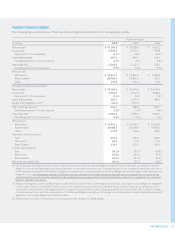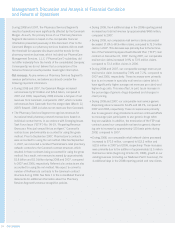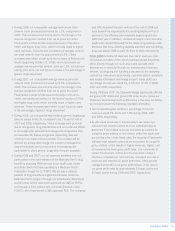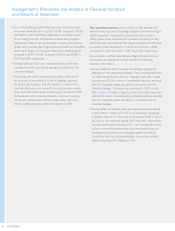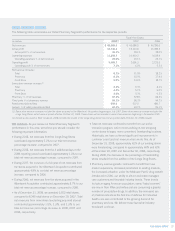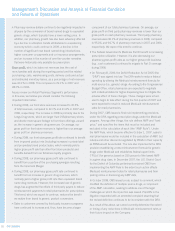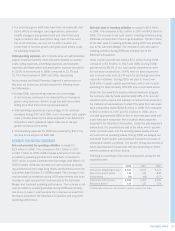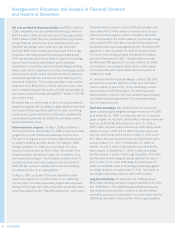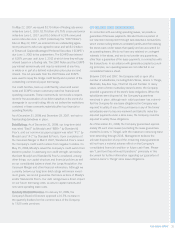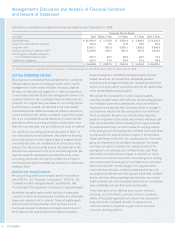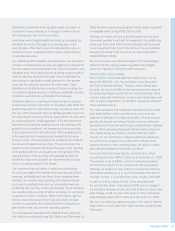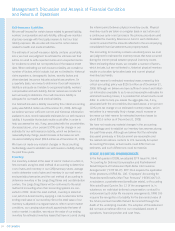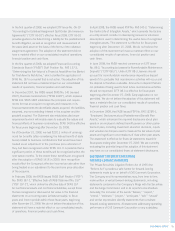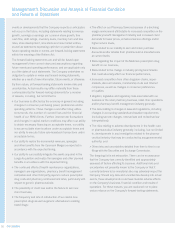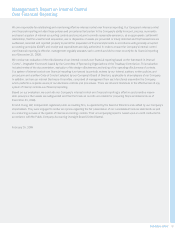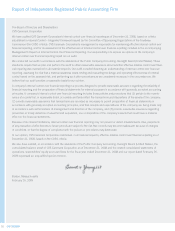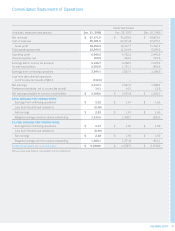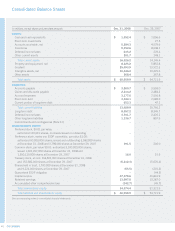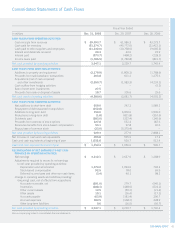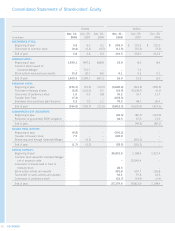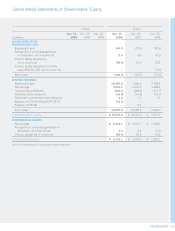CVS 2008 Annual Report Download - page 37
Download and view the complete annual report
Please find page 37 of the 2008 CVS annual report below. You can navigate through the pages in the report by either clicking on the pages listed below, or by using the keyword search tool below to find specific information within the annual report.
2008 ANNUAL REPORT 33
Goodwill and indefi nitely-lived intangible assets are subject to
impairment reviews annually, or if changes or events indicate
the carrying value may not be recoverable.
Indefi nitely-lived intangible assets are tested by comparing the
estimated fair value of the asset to its carrying value. If the
carrying value of the asset exceeds its estimated fair value, an
impairment loss is recognized and the asset is written down to
its estimated fair value.
Our indefi nitely-lived intangible asset impairment loss calculation
contains uncertainty since we must use judgment to estimate the
fair value based on the assumption that in lieu of ownership of an
intangible asset, the Company would be willing to pay a royalty in
order to utilize the benefi ts of the asset. Value is estimated by
discounting the hypothetical royalty payments to their present
value over the estimated economic life of the asset. These
estimates can be affected by a number of factors including, but
not limited to, general economic conditions, availability of market
information as well as the profi tability of the Company.
Goodwill is tested on a reporting unit basis using the expected
present value of future cash fl ows. In accordance with SFAS 142,
goodwill impairment is determined using a two-step process. The
fi rst step of the impairment test is to identify potential impairment
by comparing the reporting unit’s fair value with its net book value
(or carrying amount), including goodwill. If the fair value of the
reporting unit exceeds its carrying amount, the reporting unit’s
goodwill is not considered to be impaired and the second step
of the impairment test is not performed. If the carrying amount
of the reporting unit’s carrying amount exceeds its fair value,
the second step of the impairment test is performed to measure
the amount of impairment loss, if any. The second step of the
impairment test compares the implied fair value of the reporting
unit’s goodwill with the carrying amount of the goodwill. If the
carrying amount of the reporting unit’s goodwill exceeds the
implied fair value of the goodwill, an impairment loss is recog-
nized in an amount equal to that excess.
Our impairment loss calculation contains uncertainty since
we must use judgment to estimate each reporting unit’s future
revenues, profi tability and cash fl ows. When preparing these
estimates, we consider each reporting unit’s historical results
and current operating trends and our consolidated revenues,
profi tability and cash fl ow results and forecasts. These estimates
can be affected by a number of factors including, but not limited
to, general economic conditions, efforts of third party organiza-
tions to reduce their prescription drug costs and/or increase
member co-payments, the continued efforts of competitors to
gain market share and consumer spending patterns.
The carrying value of goodwill and intangible assets covered by
this critical accounting policy was $35.9 billion as of December 31,
2008. We did not record any impairment losses related to goodwill
or intangible assets during 2008, 2007 or 2006.
Although we believe we have suffi cient current and historical
information available to us to test for impairment, it is possible that
actual cash fl ows could differ from the estimated cash fl ows used
in our impairment tests. Due to the nature of the uncertainties
discussed previously in this document, we cannot determine a
reasonably likely change.
We have not made any material changes in the methodologies
utilized to test the carrying values of goodwill and intangible
assets for impairment, during the past three years.
Closed Store Lease Liability
We account for closed store lease termination costs in accor-
dance with SFAS No. 146, “Accounting for Costs Associated
with Exit or Disposal Activities.” As such, when a leased store
is closed, we record a liability for the estimated present value of
the remaining obligation under the non-cancelable lease, which
includes future real estate taxes, common area maintenance and
other charges, if applicable. The liability is reduced by estimated
future sublease income.
The initial calculation and subsequent evaluations of our closed
store lease liability contain uncertainty since we must use
judgment to estimate the timing and duration of future vacancy
periods, the amount and timing of future lump sum settlement
payments and the amount and timing of potential future sublease
income. When estimating these potential termination costs and
their related timing, we consider a number of factors, which
include, but are not limited to, historical settlement experience,
the owner of the property, the location and condition of the
property, the terms of the underlying lease, the specifi c market-
place demand and general economic conditions.
Our total closed store lease liability covered by this critical
accounting policy was $600.1 million as of December 31, 2008.
This amount is net of $404.7 million of estimated sublease
income that is subject to the uncertainties discussed above.
Although we believe we have suffi cient current and historical
information available to us to record reasonable estimates for
sublease income, it is possible that actual results could differ.
In order to help you assess the risk, if any, associated with
the uncertainties above, a ten percent (10%) pre-tax change in
our estimated sublease income, which we believe is a reasonably
likely change, would increase or decrease our total closed store
lease liability by about $40.5 million as of December 31, 2008.
We have not made any material changes in the reserve method-
ology used to record closed store lease reserves during the past
three years.


